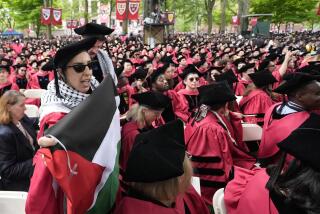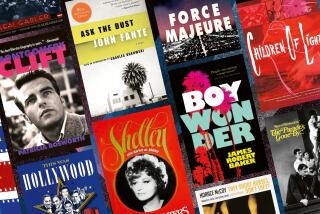Book Reviews : Grading the Volumes About Harvard
- Share via
Harvard University’s 350th anniversary has been made the occasion, this month and next, for a veritable five-foot shelf of commemorative and investigative books on the place. A sampling of these, in ascending order of importance:
Crimson in Triumph: A Pictorial History of Harvard Athletics, 1852-1985 by Joe Bertagna (Stephen Greene Lexington, Mass.; distributed by Penguin Books: $39.95)
Bertagna’s is a big picture book, something like a yearbook--no, like decades of yearbooks--with the debate team, the glee club, etc., etc., left out. It features a unique (let us all pray), 100-page appendix listing the name of every boy (and more recently every girl) who ever earned a major letter. Those who didn’t letter in field hockey and don’t care who did may take more pleasure in Bertagna’s play-by-play recapitulation of the still-thrilling 1968 Harvard-Yale football game, Harvard scoring 16 points in the final 3 1/2 minutes to “win” 29-29. The hero of that game, Frank Champi, quit the team, and football, the following season. “Football has lost its meaning for me,” he said.
The Harvard Guide to Influential Books: 113 Distinguished Harvard Professors Discuss the Books That Have Helped to Shape Their Thinking, edited by C. Maury Devine, Claudia M. Dissel and Kim D. Parrish (Harper & Row: $18.95 cloth; $6.95 paper)
Boring, touching, pretentious and amusing by turns, this book is, despite its title, a guide to nothing. The sound of 113 Harvard professors talking about good books they have read (and not lately) is like the sound of 113 coloratura sopranos warming up at once. All the same, two professors who offer their bibliographical reminiscences more as confession than as recommendation deserve mention, not to say commendation, and show how the guide works at its best.
Edward O. Wilson, author of the enormously successful and even more enormously controversial “Sociobiology: A New Synthesis” (1974), remembers “Heredity and Its Variability,” by Trofim D. Lysenko, Joseph Stalin’s court scientist. “Although I was later to see Lysenkoism for what it was,” he writes, “false in conception, political in aim, and very nearly the death of Soviet genetics, I was enchanted by this little book when I encountered it at the age of 16. It appealed to my mood of rebelliousness. It seemed to me that Lysenko was offering a radical and effective challenge to conventional science, and that even the callow and inexperienced might have a chance to proceed directly to new realms of discovery.”
Richard R. Niebuhr, third generation in a dynasty of uncompromisingly serious divinity school professors, remembers Herman Melville’s “Moby Dick”: “I can give no single reason for the abiding grasp this book, which I first read at the age of 25, has on me. Ahab says, ‘Gifted with the high perception, I lack the low enjoying power; damned, most subtly and most malignantly! damned in the midst of Paradise!”
Great Good Fortune: How Harvard Makes Its Money by Carl A. Vigeland (Houghton Mifflin: $18.95)
Deplorably, in a book so full of names, committees, acronyms and financial jargon, “Great Good Fortune” lacks an index. Astoundingly, it also lacks a table of contents. If these omissions be taken as invitation to read the book as a novel, then be it noted that, lamentably, it also lacks a plot. It is, nonetheless, an important book, the first on a subject that cannot fail to be large, for Harvard’s endowment--if a Los Angeles comparison may help--is about three times what the J. Paul Getty Trust began with.
Vigeland opens his financial portrait of the university with a description of President-Emeritus Nathan Pusey at the Harvard Club in New York, Pusey embodying in his every gesture, as Vigeland would have us believe, the old, casual, innocent Harvard. Vigeland ends his book with an extended, not to say excited account of the functioning of the new Harvard Management Company.
Key employees of the HMC, an endowment-managing innovation of the presidency of Pusey’s successor, Derek Bok, earn several times more than top Harvard professors, more even than Bok himself. The point? Though Vigeland depends too much on local color and too little on hard financial information (much of the time, clearly, Harvard managed to keep this reporter at a polite distance), he does succeed in establishing his broad thesis; namely, that since 1971, when Derek Bok took office, Harvard has started acting like the Big Business it has long since become.
Glimpses of the Harvard Past by Bernard Bailyn, Donald Fleming, Oscar Handlin, and Stephan Thernstrom (Harvard University Press: $15)
Here is a work for Harvard specialists (and if any university has its specialists, Harvard does). The work of four ultra-distinguished Harvard professors, each the occupant of an endowed chair, it presumes that the reader has the basic Harvard bibliography down. Thus, in the introduction, Bailyn claims against Samuel Eliot Morison that Harvard was not founded as a liberal arts college but as a divinity school, and not an especially liberal one. There are nuggets of that sort here, no doubt, but predictably none of the four authorities will have his views fit into a synthesis offered by any of the other four, and the result is a book whose whole is much less than its parts.
The Harvard Century: The Making of a University to a Nation by Richard Norton Smith (Simon & Schuster: $22.95)
Harvard may be 350 years from its founding; but as Smith shows us in this brilliantly written, deeply fascinating book, the Harvard we all now take for granted is not 350 years old but just over 100 years old. It was only when Charles William Eliot became president in 1869 that genteel Harvard College assumed, on the one hand, the high intellectual ambitions of a German research university and, on the other, the civic responsibilities of a national institution in the making.
Eliot, a scientist and the first scientist to head Harvard, was also, in Theodore Roosevelt’s famous phrase, “the first citizen of the Republic.” During his long presidency, he grafted those elements of his own identity onto the stem of the old, elitist, inward-looking residential college. What grew during the century that followed is Smith’s compelling subject. And if none of Eliot’s four successors was quite the remarkable character that Eliot was himself, all four were (or are) vigorous enough that Smith’s decision to tell the story of the university serially, as their stories, seems exactly right. The author of two biographies--”Thomas E. Dewey and His Times” and “An Uncommon Man: The Triumph of Herbert Hoover”--Smith uses the biographer’s skills to rescue institutional history from its usual tedium. Smith is opinionated, even sarcastic on occasion; but if you have time for one Harvard book in this anniversary, his is unquestionably the one to read.
More to Read
Sign up for our Book Club newsletter
Get the latest news, events and more from the Los Angeles Times Book Club, and help us get L.A. reading and talking.
You may occasionally receive promotional content from the Los Angeles Times.






